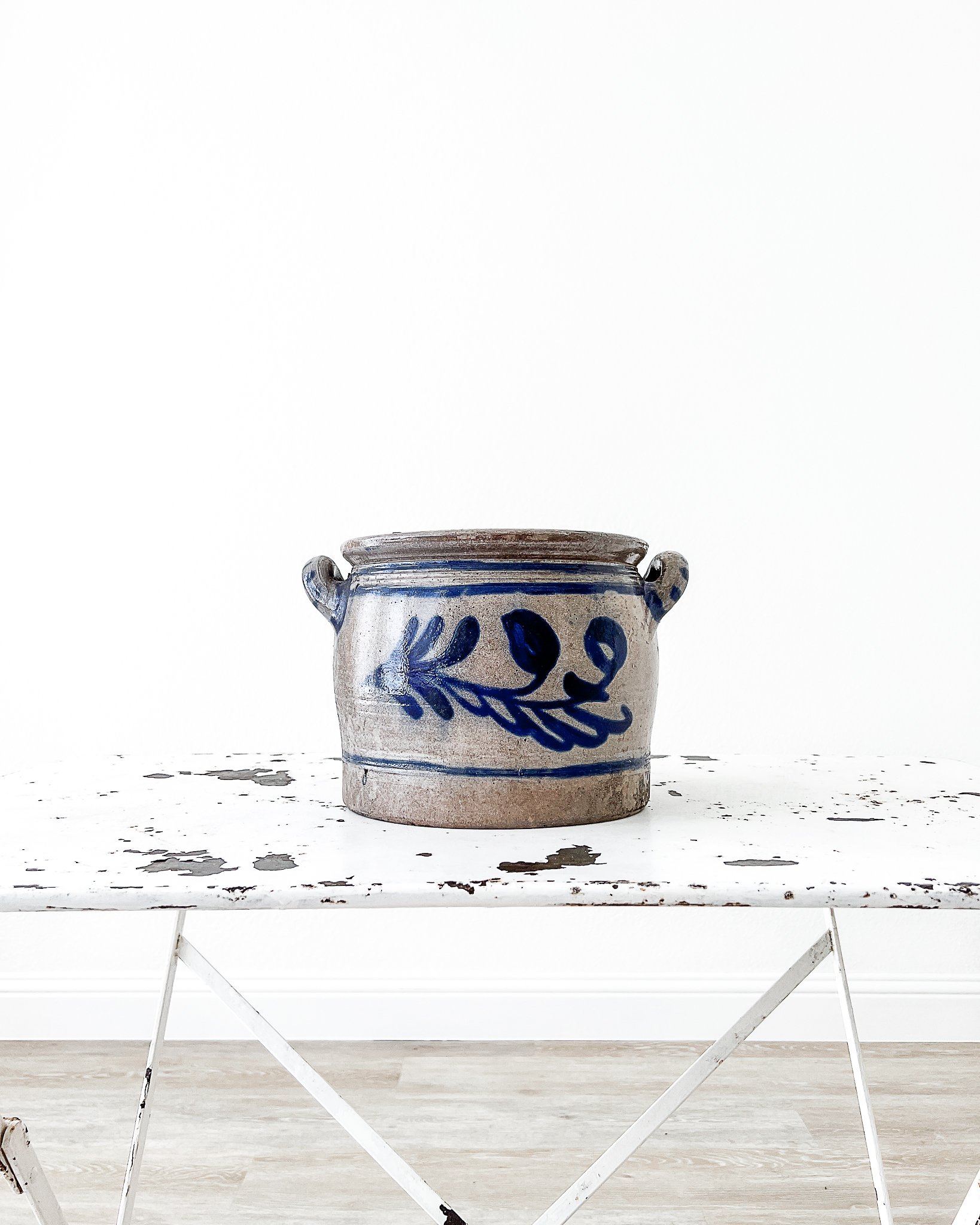Blue and Gray Salt Glazed Pot
Once used as a butter churn, and for the storage of various pickled vegetables and food items, this blue and gray salt glazed pot is hand-thrown and features a hand-painted leaf motif in a striking shade of cobalt blue. Display your favorite plant in this lovely pot to infuse your home with a bit of old world country cottage charm.
History of salt-glazed pottery: Westerwald Pottery (stoneware) is a distinctive type of salt glazed grey pottery from the area of Westerwald in Rheinland-Pfalz, Germany. The clay of the area is almost free of impurities and is perfectly suited for stoneware production. The earliest known production of salt-glazed stoneware was around 1402, when common salt was thrown into the kiln during the higher temperature part of the firing process resulting in a glossy, translucent, and slightly orange-peel-like texture on the surface of the stoneware. Bluish-gray was the predominant color of the wares, with hand-painted contrasting cobalt blue designs. In the early 18th century, potters from the Westerwald region settled in Betschdorf, France, bringing with them their technique of blue and gray salt glazed pottery.
Found in Germany
Character marks and some discoloration is present
Overall signs of wear consistent with age and use
Measures approximately 8 1/8"” H x 12” W diameter (including handles)
Opening measures 8 1/4” W
Available for pick up, local delivery, and nationwide shipping.
Need help with an item? Email Us
Request a trade discount here.
Once used as a butter churn, and for the storage of various pickled vegetables and food items, this blue and gray salt glazed pot is hand-thrown and features a hand-painted leaf motif in a striking shade of cobalt blue. Display your favorite plant in this lovely pot to infuse your home with a bit of old world country cottage charm.
History of salt-glazed pottery: Westerwald Pottery (stoneware) is a distinctive type of salt glazed grey pottery from the area of Westerwald in Rheinland-Pfalz, Germany. The clay of the area is almost free of impurities and is perfectly suited for stoneware production. The earliest known production of salt-glazed stoneware was around 1402, when common salt was thrown into the kiln during the higher temperature part of the firing process resulting in a glossy, translucent, and slightly orange-peel-like texture on the surface of the stoneware. Bluish-gray was the predominant color of the wares, with hand-painted contrasting cobalt blue designs. In the early 18th century, potters from the Westerwald region settled in Betschdorf, France, bringing with them their technique of blue and gray salt glazed pottery.
Found in Germany
Character marks and some discoloration is present
Overall signs of wear consistent with age and use
Measures approximately 8 1/8"” H x 12” W diameter (including handles)
Opening measures 8 1/4” W
Available for pick up, local delivery, and nationwide shipping.
Need help with an item? Email Us
Request a trade discount here.
Once used as a butter churn, and for the storage of various pickled vegetables and food items, this blue and gray salt glazed pot is hand-thrown and features a hand-painted leaf motif in a striking shade of cobalt blue. Display your favorite plant in this lovely pot to infuse your home with a bit of old world country cottage charm.
History of salt-glazed pottery: Westerwald Pottery (stoneware) is a distinctive type of salt glazed grey pottery from the area of Westerwald in Rheinland-Pfalz, Germany. The clay of the area is almost free of impurities and is perfectly suited for stoneware production. The earliest known production of salt-glazed stoneware was around 1402, when common salt was thrown into the kiln during the higher temperature part of the firing process resulting in a glossy, translucent, and slightly orange-peel-like texture on the surface of the stoneware. Bluish-gray was the predominant color of the wares, with hand-painted contrasting cobalt blue designs. In the early 18th century, potters from the Westerwald region settled in Betschdorf, France, bringing with them their technique of blue and gray salt glazed pottery.
Found in Germany
Character marks and some discoloration is present
Overall signs of wear consistent with age and use
Measures approximately 8 1/8"” H x 12” W diameter (including handles)
Opening measures 8 1/4” W
Available for pick up, local delivery, and nationwide shipping.
Need help with an item? Email Us
Request a trade discount here.













